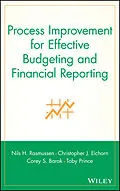"The budget and financial reporting processes are well known
sources of frustration for most CFOs. Seeking a quick fix to the
problem, the common solution is to pour more money into new and
better software. This leaves the root cause, the inefficient and
dysfunctional underlying processes and routines, unaddressed. As
this book shows, substantial and sustainable improvements are only
achieved through an holistic approach to process improvement,
technology, strategy, and people."
--Tom Henry Knudsen, Executive Vice President, Telenor Eiendom
Fornebu AS, Proven methods for improving efficiency
Corporations face a high turnover among financial managers,
rapid changes in technology, lack of time and process redesign
skills, and ongoing ambiguity about primary objectives behind the
budgeting and financial reporting processes. Amid this frenzy, it
is the fundamental efficiency of these processes that dramatically
impact overall business performance. Process Improvement for
Effective Budgeting and Financial Reporting provides financial
managers with a compelling blueprint for increasing efficiency and
eliminating waste of time and energy. Four operational experts lay
out an 80/20 plan-improving 80% of processes in 20% of the time it
would take to improve 100%-and explain a Business Process
Improvement (BPI) plan that incorporates:
* The emerging trends affecting financial managers today
* Step-by-step process implementation
* Interviews with industry leaders, consultants, and managers who
have successfully instituted BPI plans
* Appraisals of the available software that can help or hinder
the process
There is no substitute for improved efficiency. CFOs,
controllers, budget managers, and financial analysts will
significantly benefit from adding this authoritative guide to their
professional libraries.
Autorentext
NILS H. RASMUSSEN is a software solutions manager with Solver, Inc., a consulting firm that specializes in budgeting and reporting. He has participated in more than two hundred software selection and improvement projects.
CHRISTOPHER J. EICHORN is a consulting manager with Solver, Inc. He is responsible for developing and implementing budgeting and financial reporting software for midsize and large corporations. He has formerly worked with Deloitte & Touche as a CPA.
COREY S. BARAK is a senior consultant at Solver, Inc. specializing in requirements analysis and implementations, enterprise-wide budgeting, and reporting software as well as budgets, financial reporting, workflow, business processes, and training.
TOBY PRINCE is a systems analyst at Dacor, Inc., where he performs financial analysis and implementation and support of financial reporting applications and analysis. He has supervised or participated in software implementations at over thirty companies.
Klappentext
"The budget and financial reporting processes are well known sources of frustration for most CFOs. Seeking a quick fix to the problem, the common solution is to pour more money into new and better software. This leaves the root cause, the inefficient and dysfunctional underlying processes and routines, unaddressed. As this book shows, substantial and sustainable improvements are only achieved through an holistic approach to process improvement, technology, strategy, and people."
–Tom Henry Knudsen
Executive Vice President, Telenor Eiendom Fornebu AS
Proven methods for improving efficiency
Corporations face a high turnover among financial managers, rapid changes in technology, lack of time and process redesign skills, and ongoing ambiguity about primary objectives behind the budgeting and financial reporting processes. Amid this frenzy, it is the fundamental efficiency of these processes that dramatically impact overall business performance. Process Improvement for Effective Budgeting and Financial Reporting provides financial managers with a compelling blueprint for increasing efficiency and eliminating waste of time and energy. Four operational experts lay out an 80/20 plan–improving 80% of processes in 20% of the time it would take to improve 100%–and explain a Business Process Improvement (BPI) plan that incorporates:
- The emerging trends affecting financial managers today
- Step-by-step process implementation
- Interviews with industry leaders, consultants, and managers who have successfully instituted BPI plans
- Appraisals of the available software that can help or hinder the process
There is no substitute for improved efficiency. CFOs, controllers, budget managers, and financial analysts will significantly benefit from adding this authoritative guide to their professional libraries.
Inhalt
Preface.
Part One: Introduction to Business Process Improvement.
1. About Business Process Improvement.
Introduction.
Why Focus on Budgeting and Reporting Processes?
Positive Effects of BPI.
Implementing Change.
Phases of a BPI Project.
Core Budgeting and Reporting Processes.
Closing Remarks.
2. When BPI Is Valuable.
Preconditions for BPI.
What BPI Can Do for a Company.
BPI Overview.
3. Small and Large Projects and Associated Resources.
4. Return on Investment of BPI Projects.
5. Best Practices, Trends, and Technology.
Technology Trends.
Analytics and Balanced Scorecard.
Impact of the Internet.
6. Selling Change to Your Organization.
How to Sell a BPI Project.
Part Two: Business Process Improvement Project.
7. Getting Started.
Budgeting and Reporting Overview: So You Want Perfect Analytics Processes?
Preparing for the BPI Project.
Summary of Current Issues: Simplified Example.
Using Diagrams to Visualize Processes.
8. Due Diligence.
Company Values.
Risks.
Strengths and Weaknesses.
9. Improving the Budgeting Process.
Establish a Timeline.
Improve Data Entry.
Do Forecasting.
Report on Budgets.
Complete Analysis.
Enforce Accountability.
Support Enablers.
10. Revenue Budgeting.
Objectives.
Customer Needs.
Dimensions and Chart of Account Considerations.
Drivers.
Top-Down or Bottom-Up Budgeting Approach.
Assumptions.
Special Considerations.
Users.
Best Practices.
11. Employee Budgeting.
Objectives.
Customer Needs.
Dimensions and Chart of Account Considerations.
Top-Down or Bottom-Up Approach.
Drivers.
Assumptions.
Special Considerations.
Users.
Best Practices.
12. Cost of Sales and Operating Expenses.
Objectives.
Customer Needs.
Dimensions and Chart of Account Considerations.
Top-Down or Bottom-Up Approach.
Drivers.
Assumptions.
Special Considerations.
Users.
Best Practices.
13. Capital Expenses.
Objectives.
Customer Needs.
Dimensions and Chart of Account Considerations.
Top-Down or Bottom-Up Approach.
Drivers.
Assumptions.
Special Considerations.
Users.
Best Practices.
14. Balance Sheet and Cash Flow Statements.
Objectives.
Customer Needs.
Dimensions and Chart of Account Considerations.
Top-Down or Bottom-Up Approach.
Drivers.
Assumptions.
Special Considerations.
Users.
Best Practices.
15. Alternative Budgeting Approaches.
Zero-Based Budgeting.
Acti…
